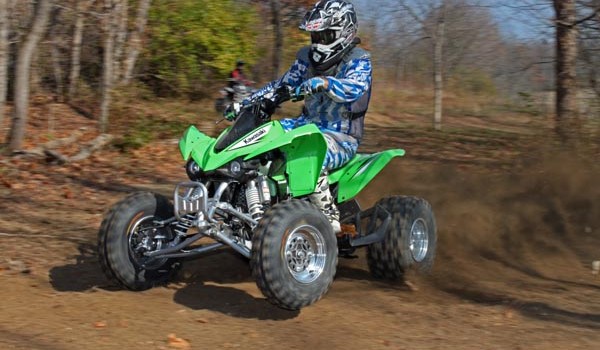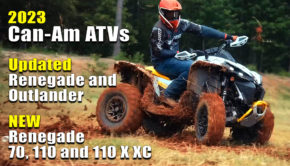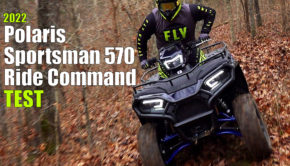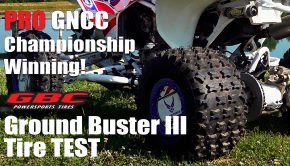2011 Kawasaki KFX450R Review
 Purchasing a first year model ATV is a lot like going on a blind date. Anticipation is high, but there is also the real possibility that things won’t go so well. When picking up our 2011 Kawasaki KFX450R test unit from Cycle Specialties in Cincinnati, Ohio, we felt like we were taking her out for our third or fourth date. We were still anxious; however, the feelings of nervousness were long gone. We know what the Kawasaki likes, how it will react, and what it takes to get what we want out of her.
Purchasing a first year model ATV is a lot like going on a blind date. Anticipation is high, but there is also the real possibility that things won’t go so well. When picking up our 2011 Kawasaki KFX450R test unit from Cycle Specialties in Cincinnati, Ohio, we felt like we were taking her out for our third or fourth date. We were still anxious; however, the feelings of nervousness were long gone. We know what the Kawasaki likes, how it will react, and what it takes to get what we want out of her.
Our first experience with the KFX came back in 2009 where we track tested at Milestone Motocross Park in California. Our second encounter was a brief track test where we put several hours on the Kawasaki at the Badlands Off Road Park in Attala, Indiana. Heading into our 2011 test, we knew the KFX was a bit soft spoken about demanding respect, but also knew how gifts from the aftermarket really made her come out of her shell.
Now, in its fourth year of production, the KFX450R has remained mainly unchanged since its inception with the exception of a few improvements in reliability, the most obvious of which were the wiring harness updates for better waterproofing. While some media sources are whining about a lack of updates throughout the 450 class, we believe Kawasaki deserves tremendous credit for being one of only three manufacturers offering a current model year machine––down from 7 just two years ago.
 Powering the KFX is a 449cc liquid cooled four-stroke engine Kawasaki borrowed from the KX450F dirt bike back in 2008 which was reconfigured for a more ATV friendly power delivery with minor head and cam changes. The head features a four-valve, double overhead cam configuration with titanium valves and aluminum valve spring retainers along with a forged piston to reduce reciprocating weight for more efficient and reliable operation at high RPMs. The engine also features a trick, lightweight, titanium head pipe and quick-change clutch cover making clutch changes a snap. Electric starting comes standard although Kawasaki does offer a kick-start conversion system for hard racers looking to shave weight.
Powering the KFX is a 449cc liquid cooled four-stroke engine Kawasaki borrowed from the KX450F dirt bike back in 2008 which was reconfigured for a more ATV friendly power delivery with minor head and cam changes. The head features a four-valve, double overhead cam configuration with titanium valves and aluminum valve spring retainers along with a forged piston to reduce reciprocating weight for more efficient and reliable operation at high RPMs. The engine also features a trick, lightweight, titanium head pipe and quick-change clutch cover making clutch changes a snap. Electric starting comes standard although Kawasaki does offer a kick-start conversion system for hard racers looking to shave weight.
 Along with its five speed manual transmission, the KFX is the only 450 on the market currently being produced with reverse. This is a huge advantage in the woods and will save you a lot of time on the motocross track if you blow a turn and get hung up on a berm.
Along with its five speed manual transmission, the KFX is the only 450 on the market currently being produced with reverse. This is a huge advantage in the woods and will save you a lot of time on the motocross track if you blow a turn and get hung up on a berm.
Kawasaki feeds the KFX its air/fuel recipe via their 32-bit fuel injection system, which features a 42mm throttle body. Like the other fuel injected machines on the market, the KFX features an open loop fuel injection system which measures throttle position and engine speed along with intake air pressure and temperature, allowing it to adjust the air fuel mixture for varying altitudes and air temperatures.
You will need to add an aftermarket fuel management system in order to compensate for the addition of a performance exhaust or other engine hop-ups. The same holds true on any fuel-injected sport ATV.
 One of the biggest highlights of this machine is its chassis. The beefy aluminum frame was designed to be light and responsive with high torsional rigidity. A single box-tube lower front frame rail mounts the lower A-arms very close together. This allows for the use of longer A-arms and reduces unwanted bump steer. The arms feature steel construction and are set up with very little caster, an indication of the KFX’s aggressive steering manners. Other chassis highlights include its lightweight removable aluminum sub frame and a cast aluminum swingarm that looks like a work of art. Complementing the frame, the swingarm was designed to be light and rigid through its use of curved lines, rounded edges, and varying wall thicknesses.
One of the biggest highlights of this machine is its chassis. The beefy aluminum frame was designed to be light and responsive with high torsional rigidity. A single box-tube lower front frame rail mounts the lower A-arms very close together. This allows for the use of longer A-arms and reduces unwanted bump steer. The arms feature steel construction and are set up with very little caster, an indication of the KFX’s aggressive steering manners. Other chassis highlights include its lightweight removable aluminum sub frame and a cast aluminum swingarm that looks like a work of art. Complementing the frame, the swingarm was designed to be light and rigid through its use of curved lines, rounded edges, and varying wall thicknesses.
 KYB shocks at both ends provide the KFX’s suspension movement. The front shocks are preload, compression, and rebound adjustable with a progressively wound spring providing essentially a dual rate spring setup. Out back, the rear KYB also features a progressively wound spring and is equally adjustable. Plus it has the additional feature of separate high and low speed compression damping. The front shocks control 8.5 inches of movement while the rear wheels travel a full 10 inches.
KYB shocks at both ends provide the KFX’s suspension movement. The front shocks are preload, compression, and rebound adjustable with a progressively wound spring providing essentially a dual rate spring setup. Out back, the rear KYB also features a progressively wound spring and is equally adjustable. Plus it has the additional feature of separate high and low speed compression damping. The front shocks control 8.5 inches of movement while the rear wheels travel a full 10 inches.
The KFX was designed to be very stable despite its trail friendly width of 46.1 inches. It has a low stance; its engine is mounted low in the chassis; and despite its trail friendly size tires, the Kawasaki has a very low seat height at just 30.9 inches. They even relocated the battery to the lower frame rails in front of the engine to help get the center of gravity down. Its wheelbase of 49.4 inches is a bit shorter than most of its competitors–– undoubtedly part of Kawasaki’s quest for responsive handling.
 The KFX is slowed by two dual piston equipped hydraulic disc brakes up front and a single hydraulic disc brake in the rear. The rear brake features a lightweight petal style rotor reducing unsprung weight and providing better brake pad clean out. A rear parking brake is equipped and is controlled by a left handlebar mounted lever.
The KFX is slowed by two dual piston equipped hydraulic disc brakes up front and a single hydraulic disc brake in the rear. The rear brake features a lightweight petal style rotor reducing unsprung weight and providing better brake pad clean out. A rear parking brake is equipped and is controlled by a left handlebar mounted lever.
 The KFX comes with a nice set of aluminum rims with reinforcing rings on the rear wheels for extra durability in rocks and on punishing jump landings. The rims come wrapped in 21×7-10 front and 20×10-9 rear Dunlop tires.
The KFX comes with a nice set of aluminum rims with reinforcing rings on the rear wheels for extra durability in rocks and on punishing jump landings. The rims come wrapped in 21×7-10 front and 20×10-9 rear Dunlop tires.
The KFX450R’s cockpit is adorned with a number of high end racy items such as 1 1/8 inch Renthal Fat Bars, an adjustable reach front brake lever, quick adjust clutch perch and a two tone seat cover with a rough top and smooth side surfaces designed to allow freedom of movement while standing and plenty of traction while sitting. Riders of different sizes can somewhat accommodate themselves by switching the handlebar mounts around to move the bars slightly more forward or rearward.
TEST
Having tested the KFX on a smooth, flat motocross track with tons of turns, and on sandy wooded trails, we decided to try the 450 out on some faster rougher terrain for 2011. Our first stop was Horseshoe Bend MX in Walton, KY. We then went to a private, wooded motocross track located farther north. Both tracks offered jumps of various sizes, lots of altitude changes, and Horseshoe provided plenty of nasty braking and acceleration bumps.
Unlike most other fuel injected machines, the KFX has a choke/idle speed knob located on the left side of the machine. On days in the 40s and below, we found the choke to be a benefit although it is difficult to locate the first couple of times. Push the start button, and the KFX sparks to life although it likes to take a minute to warm up before hitting the track.
For a high performance machine, the KFX450 has a very quiet exhaust. Like most fuel injected 450s, the Kawasaki’s power delivery is rather linear. The engine pulls well in the bottom third of the throttle before building seamlessly into the midrange. Its low-end power is notably better than the Suzuki or Can-Am 450s, which makes getting through slow technical sections easier. Its tractable low-end power will be a real asset on slippery, muddy climbs where traction is key.
 Midrange power is good, and pulls hardest just as you reach the top third of the throttle. With its power focused throughout the bottom end and midrange, the KFX engine feels idiot-proof when attacking corners or steep hills in a higher gear. Despite its good nature, the KFX is packing a true high performance power-plant which makes it a thrill to ride. There’s plenty of power for tackling steep climbs and it can clear all but the largest of leaps. As the engine reaches the top third of the RPM range, power begins tapering off, so there’s no need to wring the motor out. Simply grab the next gear and let the engine work. For novice to intermediate level high performance enthusiasts, the KFX has a fun, easy to ride power plant that works well on the track or trail. Focusing the power in the lower RPMs and keeping the rider off the rev limiter will undoubtedly help the engine live longer.
Midrange power is good, and pulls hardest just as you reach the top third of the throttle. With its power focused throughout the bottom end and midrange, the KFX engine feels idiot-proof when attacking corners or steep hills in a higher gear. Despite its good nature, the KFX is packing a true high performance power-plant which makes it a thrill to ride. There’s plenty of power for tackling steep climbs and it can clear all but the largest of leaps. As the engine reaches the top third of the RPM range, power begins tapering off, so there’s no need to wring the motor out. Simply grab the next gear and let the engine work. For novice to intermediate level high performance enthusiasts, the KFX has a fun, easy to ride power plant that works well on the track or trail. Focusing the power in the lower RPMs and keeping the rider off the rev limiter will undoubtedly help the engine live longer.
 Serious racers and equally fast sport riders will want to open up the Kawasaki’s intake and exhaust to access more top-end power and take advantage of its generous amount of untapped engine performance. These mods are typical for any fuel injected 450, as they are all somewhat corked up by EPA restrictions in stock form.
Serious racers and equally fast sport riders will want to open up the Kawasaki’s intake and exhaust to access more top-end power and take advantage of its generous amount of untapped engine performance. These mods are typical for any fuel injected 450, as they are all somewhat corked up by EPA restrictions in stock form.
Shifting on the Kawasaki is virtually flawless. Clicking up and down through the gears is smooth and miss-shifts were virtually nonexistent. Having reverse is a benefit for even dirt hard track riders and the KFX has our favorite reverse setup of all the sport quads on the market. Simply pull in the clutch in first gear, depress the right thumb lever mounted on the throttle housing ,and shift down to reverse. Clutch action is smooth with a light pull and never seemed to fade.
Handling on the KFX is good and on the verge of greatness. For its trail friendly width, it’s quite stable through the turns, exhibiting less body roll than the Honda or Can-Am 450s. This was a huge benefit on our private track’s technical off-camber hillside turns. The Kawasaki has very light and responsive steering, a good thing once the machine is dialed in. If your suspension and toe in settings are off, the front end can get quite nervous on rough, uneven bumps.
 For our third date with the KFX, we wanted to see how good we could make it handle with some suspension tuning. In order to get the most reliable results from our shock testing, we replaced the Kawasaki’s stock tires with Kenda Kutter XCs. The Kendas bounce less, offer better directional control, and are the same size as the stock tires, requiring no change in gearing. Unless you’re racing, go ahead and wear out those stock tires, but try the following suspension settings on your KFX. They worked well for us.
For our third date with the KFX, we wanted to see how good we could make it handle with some suspension tuning. In order to get the most reliable results from our shock testing, we replaced the Kawasaki’s stock tires with Kenda Kutter XCs. The Kendas bounce less, offer better directional control, and are the same size as the stock tires, requiring no change in gearing. Unless you’re racing, go ahead and wear out those stock tires, but try the following suspension settings on your KFX. They worked well for us.
After two days of tinkering with the shocks, we had increased preload at both ends; our ride height set at 8 inches in the front and 7.5 inches in the rear with 190 pound Dave Trimble on board. Front shock compression was set 11 clicks out and rebound was set 19 clicks out. We did speed rebound damping up quite a bit to allow the front shocks to recover better in braking bumps. After adding more preload to the rear shock to give it more bottoming resistance, we gradually kept backing out the rear shocks high-speed compression looking for greater plushness over small bumps. In the end, our high-speed compression damping was set all the way out. The low-speed compression was left stock, also backed all the way out and rebound set at 10 clicks out. We set the front wheels up parallel, afraid that adding any toe in would amplify its aggressive steering.
 Dialed in, the KYB shocks felt firm yet responsive and we were going faster everywhere on the track. Our search for greater responsiveness allowed the shocks to react better to small square-edged bumps. The shocks are now more resistant to packing, allowing the wheels to track better through whoops and deep braking bumps. With more bottoming resistance dialed in, we found ourselves going bigger than we had with their original settings and we were surprised how well we got the shocks working compared to stock. While another inch of front wheel travel wouldn’t hurt, the stock shocks offer a wide range of adjustment and are a good match for the stock engine’s performance.
Dialed in, the KYB shocks felt firm yet responsive and we were going faster everywhere on the track. Our search for greater responsiveness allowed the shocks to react better to small square-edged bumps. The shocks are now more resistant to packing, allowing the wheels to track better through whoops and deep braking bumps. With more bottoming resistance dialed in, we found ourselves going bigger than we had with their original settings and we were surprised how well we got the shocks working compared to stock. While another inch of front wheel travel wouldn’t hurt, the stock shocks offer a wide range of adjustment and are a good match for the stock engine’s performance.
With the suspension and front wheel toe dialed in, the KFX’s responsive steering is a lot more manageable while still just a bit nervous. Our level of control in braking bumps was greatly improved allowing us to brake later and pick up our corner entry speed a bit.
 Despite having a shorter wheelbase, the Kawasaki is very predictable launching into the air, flying straight and low off jumps. Its low center of gravity makes the machine feel light and maneuverable both in the air and on the ground.
Despite having a shorter wheelbase, the Kawasaki is very predictable launching into the air, flying straight and low off jumps. Its low center of gravity makes the machine feel light and maneuverable both in the air and on the ground.
Braking performance is superb, offering excellent power, feel, and control at both ends. The combination of excellent brakes and aggressive steering give the KFX an edge when you’re trying to steal the inside line from the competition.
The KFX450 has a compact ergonomic layout. The triangle between the bars, seat, and foot pegs best suits riders 6 feet tall and under. Riders who really hang off the side in corners may want a bit more knee room, which is easily obtainable by removing the front and/or rear fender extensions. A slim midsection makes gripping the machine with your knees easy. We found the Renthal bar bend comfortable as well as the shape and operation of all the controls. There is a bit more vibration felt through the handlebars than on most other 450s due to the KFX’s rigid aluminum frame, but nothing intolerable or incurable.
While its seat has been criticized for being hard, it has a sweet cover that offers plenty of traction while sitting and less traction on the sides allowing you to move forward and rearward while standing. Honestly, we didn’t find the seat too uncomfortable during our shorter track sessions, but if you are a trail rider, you can get a softer foam from Quad Tech.
CONCLUSION:
We have discussed this machine at length with many aftermarket manufacturers and all agreed that the KFX has a strong chassis and reliable engine that will provide long-term performance as long as you keep up with routine maintenance and don’t go overboard with motor modifications. Not all machines in the 450 class share the Kawasaki’s level of reliability.
Most experienced sport enthusiasts could go down to their Kawasaki dealer, pick up a KFX, and have all the performance and good times they will ever need. Like most stock 450s, experienced racers may find the KFX to be bit soft spoken in stock form; however, it can easily be turned into a screamer. Dialed in, it handles well in stock trim, and outfitted for racing, the KFX may have the best handling chassis in the class.
At this point, we could see ourselves married to the 2011 Kawasaki KFX450R. Well, at least for the next few years.
Write a review on the Kawasaki KFX450R for thousands of other ATV enthusiasts to read in our User Review Section.
SpecificationsMake/Model |
|
| Manufacturer | Kawasaki |
| Model | KFX 450R |
| Year | 2011 |
| MSRP | $8,099 |
| Color | Lime Green |
Engine |
|
| Displacement | 449cc |
| Engine Type | four-stroke single, DOHC, four valves per cylinder |
| Bore X Stroke | 96 x 62.1mm |
| Compression Ratio | 12:1 |
| Cooling System | Liquid-cooled |
| Carburetion | 32-bit digital, with 42mm Keihin throttle body |
| Ignition | |
| Starting System | Electric |
Drive Train |
|
| Transmission | Five-speed with reverse |
| Drive Train | Two-wheel drive, chain |
| Chassis/Suspension/Brakes | |
| Frame | Aluminum |
| Front Suspension | Dual A-arms, coil-over shocks / 8.5 in |
| Rear Suspension | Swingarm with piggy-back reservoir shock, dual-rate spring / 10.0 in |
| Front Brakes | Dual 163mm discs with two-piston calipers |
| Rear Brakes | 200mm petal-type rotor with single-piston caliper |
| Front Tires | AT21x7-10 |
| Rear Tires | AT20x10-9 |
Dimensions |
|
| Length | 71 inches |
| Width | 46 inches |
| Height | 41.9 inches |
| Wheelbase | 49.4 inches |
| Seat Height | 30.9 inches |
| Ground Clearance | 4.3 inches |
| Dry Weight | 364 lb |
| Fuel Capacity | 2.6 gal |
Other |
|
| Instruments | Hi-temp, neutral, reverse, and low fuel indicator lights |
| Lighting | Dual removable headlights |
2011 Kawasaki KFX450R
Summary: Most experienced sport enthusiasts could go down to their Kawasaki dealer, pick up a KFX, and have all the performance and good times they will ever need. Like most stock 450s, experienced racers may find the KFX to be bit soft spoken in stock form; however, it can easily be turned into a screamer. Dialed in, it handles well in stock trim, and outfitted for racing, the KFX may have the best handling chassis in the class.













